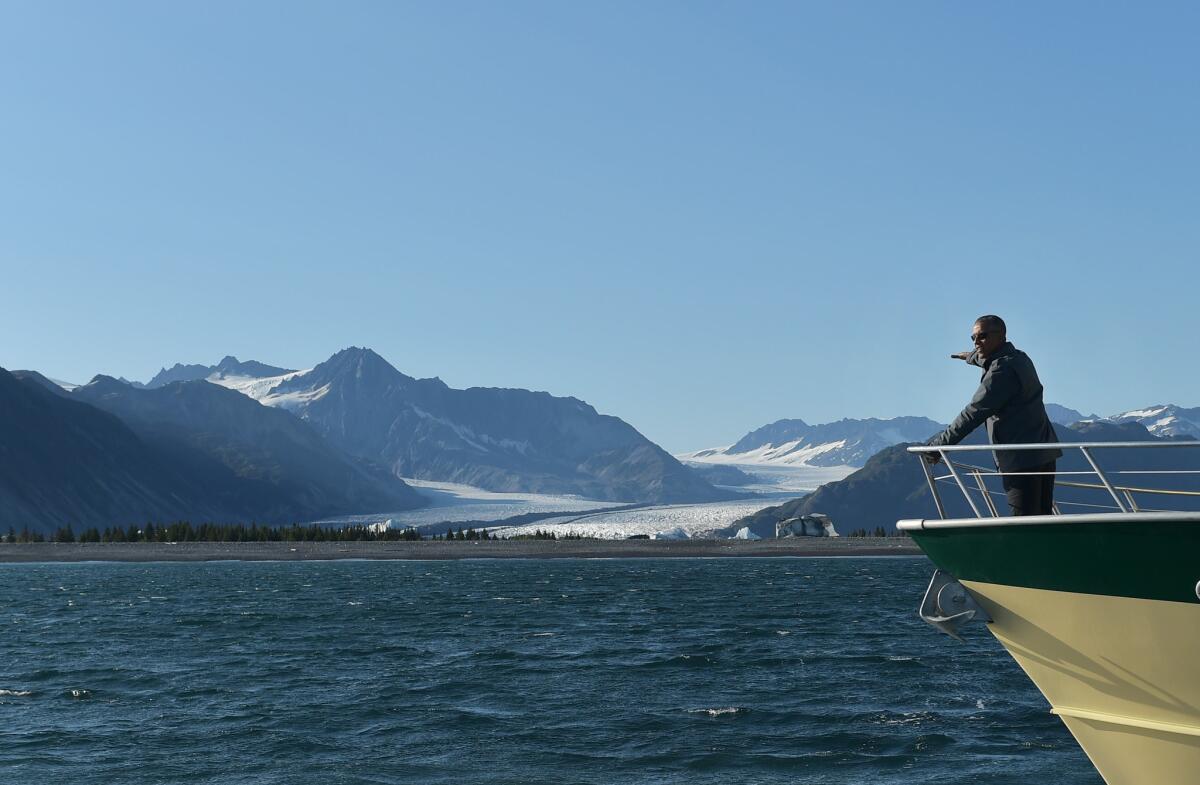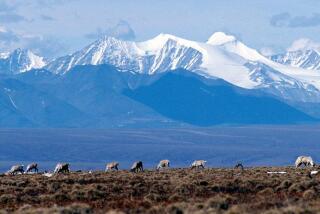Alaska relishes extended visit by President ‘Bearack’ Obama

President Obama points to Bear Glacier during a boat tour of Alaska’s Kenai Fjords National Park on Sept. 1.
Reporting from Anchorage — For a state used to the briefest of presidential stopovers, President Obama’s extended visit this week has been an opportunity to savor — and, for some, to push back against his agenda.
In the sparsely populated 49th state, waving Alaskans have lined motorcade routes. On Tuesday near Seward, Espresso Simpatico made him an offer he couldn’t refuse — if only he’d stopped in: “President Obama drinks free.” In Dillingham, where he touched down in the rain Wednesday, a wildlife stop was dubbed the “Bearack Viewing Area.”
But this is a red state governed just years ago by conservative sensation Sarah Palin. The Last Frontier has never voted for the visiting Democrat. Its congressional delegation is solidly Republican. Gov. Bill Walker, who won election as an independent in 2014, is a former member of the GOP.
And the Alaska Republican Party has rolled out the not-very-welcome mat. When the president gave a speech Monday rebuking climate-change “deniers,” the state party tweeted, “This president is really a downer.” When he visited melting glaciers Tuesday, it sneered, “#Obama wilderness hike to Exit Glacier. Alaskans are falling over laughing.”
Rep. Don Young (R-Alaska) blasted Obama’s speech at a conference here of Arctic nation leaders, calling it a “song and dance on climate change” and saying that it “was exactly what we didn’t want from the president, which was to use Alaska as a prop for an extreme, economy-killing, environmental agenda.”
NEWSLETTER: Get the day’s top headlines from Times Editor Davan Maharaj >>
And in Dillingham on Bristol Bay, Alaska Natives, commercial fishermen and those in the tourism industry offered him a mixed message.
Bristol Bay is the world’s biggest sockeye salmon fishery. In December, Obama permanently protected 52,000 square miles from offshore drilling. But the Pebble Mine project — a proposal for the biggest open-pit mine in North America — is still a possibility there.
As Obama made his way from Anchorage to Dillingham on Wednesday, eager residents had gathered to say, basically, “Thank you, but you’re not done.” Or as one anti-Pebble Mine sign that cropped up in Dillingham put it: “Thank You For Protecting Bristol Bay From Off-Shore Drilling. Now Protect Our Rivers & Streams.”
Obama’s first stop in Dillingham was proof that salmon is king here on the southwest edge of Alaska. The First Fisherman held up a silver salmon while posing for news cameras at Kanakanak Beach. He sampled salmon jerky. (“Outstanding,” was his politic review.) He talked to local fisherwomen.
And he said the scale of the salmon fishery here is remarkable and key to the economy and the country both.
“That’s part of the reason why it’s so critical that we make sure that we protect this incredible natural resource,” he said, adding, to applause from the crowd, “That’s one of the reasons we’ve shut off oil and gas exploration here.”
Marilyn Heiman, director of the U.S. Arctic Program for Pew Charitable Trusts, said Wednesday that “the people of Bristol Bay really want to thank the president for what he’s done. They really appreciate that his administration had recognized the Bristol Bay is a treasure that should be protected.”
To Kimberly Williams, a Bristol Bay fisherwoman and executive director of the Nunamta Aulukestai coalition of Alaska Native Villages, the president deserves a warm welcome, “but we still need his help to protect the salmon’s Bristol Bay spawning grounds from the Pebble Mine.”
Obama’s final Alaska stop was the town of Kotzebue; when he touched down, he became the first sitting president to visit the Arctic. As he told the audience during a speech at Kotzebue School, “I couldn’t be prouder to be the first and to spend some time with all of you.”
Kotzebue Fire Chief Sean Ralston estimated the crowd packed into the school gym at 1,065, a respectable number in a rural region on a school night. To put it in perspective, however, the population of the town is just around 3,200. A third of the population came out to listen.
Before visiting Kotzebue, Obama did a flyover of Kivalina, a tiny village on a barrier island that can be reached only by air. When Millie Hawley, Kivalina’s tribal president, introduced Obama in the Kotzebue gym, she explained why a president concerned about climate change would buzz her town.
“As it stands now, my current home may not exist 10 years from now,” she said. “Scientific research done by the Alaska Native Tribal Health Consortium predicts that our 8-mile island we call home may be underwater in the Chukchi Sea.
“As citizens of America, my people still live in conditions the rest of America considers Third World,” she said. “We’re also on the front lines of climate change, with erosion impacting our community in a very serious way.”
Obama described the island’s predicament, that “waves sweep across the entire island at times, from one side clear across to the other,” and that the village of 403 must relocate.
The problem though, is that the village cannot afford to move. The borough in which it resides cannot afford to help it move. And the state is suffering under a $3.5-billion deficit.
“Think about it,” Obama said. “If another country threatened to wipe out an American town, we’d do everything in our power to protect it. Well, climate change poses the same threat right now. And that’s why I care so deeply about this.”
Wednesday night he announced that he was deputizing an existing commission to help rural communities deal with issues of coastal erosion. The Denali Commission, he said, is “committing $2 million to support voluntary relocation efforts for vulnerable rural communities.”
The Kotzebue crowd cheered, but the fact remains that at least three rural communities face the need to relocate because of the ravages of climate change. The price tag for moving Kivalina alone has been estimated at anywhere from $95 million to $400 million.
Past presidents have come to Alaska to fly-fish and meet with visiting heads of state, welcome a pope and rally American troops. More often, though, it’s been simply to refuel Air Force One en route to or from one far-flung destination or another.
“We’re excited to have a president come up and it’s actually a destination, it’s not just a low-on-fuel stop,” Walker told reporters as he traveled back to his state with the president Monday on Air Force One, adding that it was great Obama could “get out and touch Alaska, be part of it.”
During their time together, Walker talked with the president about previous presidential visits. There was Jimmy Carter’s fishing trip, and the time Ronald Reagan stayed over at then-Sen. Frank Murkowski’s Fairbanks home, only to have the hot water run out.
William McKinley’s presence in Alaska was in name only, as the inspiration for the designation of the state’s tallest peak before Obama announced this weekend that it would be renamed Denali. Warren Harding was the first president to visit Alaska during its days as a territory, stopping at the governor’s home just weeks before he died.
“I didn’t bring that one up,” Walker said.
On Wednesday, during his history-making trip north of the Arctic Circle, Obama told the Kotzebue crowd another Alaska presidential story.
“When FDR visited, Franklin Delano Roosevelt, his opponents started a rumor that he left his dog, Fala, on the Aleutian Islands and spent 20 million taxpayer dollars to send a destroyer to pick him up,” Obama recounted.
“Now, I’m amazed that anybody would make something up about a president,” he continued, as the audience laughed. “But FDR did not take it lying down. He said, ‘I don’t resent attacks. And my family doesn’t resent attacks. But Fala does resent attacks. He’s not been the same dog since.’ “
In some ways it’s fitting that a president born in Hawaii is making some history in Alaska. The country’s two youngest, noncontiguous states have often partnered in Congress, even with delegations from opposite sides of the aisle, to fight for their mutual interests.
Obama’s interest also is personal. As he’s struggled to break out of the presidential bubble in recent years, it’s inspired a joke — “the bear is loose” — among his staff and press corps.
There Obama was Tuesday boating past the Bear Glacier, after hiking with survivalist reality star Bear Grylls. “When I’m not president, you’ll find me over there in that cabin,” he told reporters at one point riding through Resurrection Bay.
Twitter: @marialaganga
Twitter: @mikememoli
ALSO
Obama secures last vote needed to assure Iran deal
In Alaska, Obama warns against climate change but OKs drilling
White House insists Obama has no post-presidency plans as Columbia University rumor swirls
More to Read
Get the L.A. Times Politics newsletter
Deeply reported insights into legislation, politics and policy from Sacramento, Washington and beyond. In your inbox three times per week.
You may occasionally receive promotional content from the Los Angeles Times.












